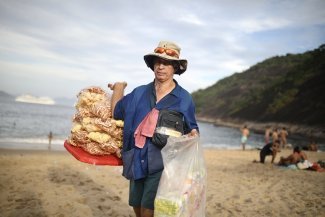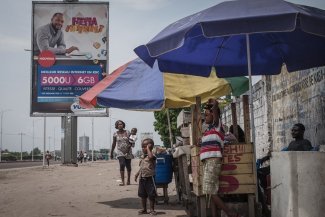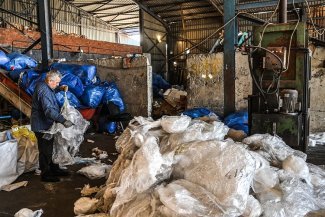
In downtown Nairobi, George Kimondo runs a shop selling second-hand women’s clothes, or mitumba. Since quitting his job with a security company to start his business eight years ago, George says he now earns as much as four times his previous monthly salary.
He started by hawking clothes in offices and on the streets, before setting up a shop after one year. “Business is good during the holidays and at the end of the month,” he says, when he can generate as much as US$1000 per week.
But George’s success as a businessman might be coming end. In March 2016, the six members of the East African Community – Kenya, Rwanda, Uganda, Tanzania, Burundi and South Sudan – jointly agreed to phase out the importation of second-hand clothes and shoes over three years. In a joint statement issued during a 2016 summit in Arusha, Tanzania, the EAC presidents said the move would help boost local cotton, textile, apparel and leather industries.
Currently, imported second-hand goods are big business throughout Africa.
According to USAID, second-hand clothing generates approximately 355,000 jobs in the EAC and some US$230 million in income (which USAID describes as a conservative estimate).
From second-hand cars to medical equipment and clothes, critics say the continent is a dumping ground for used consumer goods from the Global North and they commend the EAC for taking steps to reverse the current situation.
However, opponents of the ban say it will cut off an important source of inexpensive, good quality clothing from trading blocs such as the United States and the European Union, while hurting workers and business owners, not to mention denying the region millions in tax revenues. Kenya, for example, collected US$54 million in tariffs on 100,000 tons of imported used clothing in 2013, according to Global Recycling.
The phase-out of used clothing, which has already begun, will continue until 2019. It is part of EAC’s Vision 2050, a blueprint on economic and social prosperity, and the EAC’s Industrialisation Policy, both of which aim to enhance a manufacturing sector that currently only contributes 8.7 per cent to the regional gross domestic product to 25 per cent by 2032.
“Making the choice is simple, we might suffer consequences”
Already Uganda, Rwanda and Tanzania have raised taxes for used clothes while offering incentives to manufacturers to invest in local textile sectors.
Tanzania has doubled levies on the importation of used clothing from US $0.20 to US $0.40 per kilogramme (kg), in addition to announcing plans to train 2,000 young people in tailoring every year.
Uganda, meanwhile, has increased the environmental levy imposed on used clothes from 15 per cent to 20 per cent of the cost and freight insurance value.
Rwanda has probably made the biggest commitment to stop importing used clothes by increasing the tax on used clothes from US$0.20 per kg to US$4 this financial year. That levy is set to increase to US$5 per kg.
The United States has responded strongly to the EAC ban, threatening to remove Kenya, Uganda, Rwanda and Tanzania from the African Growth and Opportunity Act (AGOA) which offers preferential trade tariffs to participating countries in sub-Saharan Africa [editor’s note: Burundi and South Sudan are already no longer part of the deal].
The US Secondary Materials and Recycled Textiles Association, which initiated a petition to review the agreement with these four countries, said the move to curb used clothing imports would act as a barrier to US trade, which goes against the terms of AGOA.
As a result of US pressure, Kenya – which, according to TradeMark East Africa “would have far more to lose from suspension of its duty-free textile export privileges under AGOA than would any of the other EAC countries” – decided to repeal its plan to introduce a US$0.40-per-kg duty on second-hand clothes in June 2017. TradeMark East Africa says that “Kenya sold US$394 million worth of textiles and clothing on the US market last year, compared to the total US$43 million sum of AGOA trade for Rwanda, Tanzania and Uganda” and this likely accounts for Kenya’s unwillingness to exit the trade agreement.
However, as Peter Njoroge, the former director of trade at the EAC and now a regional trade expert, points out, the decision to ban used clothing imports cannot be ignored or overturned by one country alone.
“The EAC is a customs union which requires that partner states make joint decisions,” Njoroge told Equal Times.
To date, Rwanda, Uganda and Tanzania have maintained their position on the ban. President Paul Kagame of Rwanda, who has been its most outspoken supporter, was quoted by local media as saying that second hand clothes compromise the dignity of his citizens, and that US pressure would not make a difference.
“This is the choice we find that we have to make. As far as I am concerned, making the choice is simple, we might suffer consequences. Even when confronted with difficult choices, there is always a way,” he said.
“Rwanda and other countries in the region that are part of AGOA, have to do other things, we have to grow and establish our industries,” he said.
Debating the impact
Elsewhere, the ban on the importation of used clothes into the region has received mixed reactions. Mukhisa Kituyi, secretary-general of the United Nations Conference on Trade and Development, told Equal Times that “the decision to impose a ban on second-hand clothing pours cold water on trade agreements such as the Africa Growth Opportunity Act. EAC states should speak as one when highlighting different stands taken on the ban”. Kituyi also called on both EAC countries and the US to reach a mutual understanding.
However, Lilian Awinja, chief executive of the East African Business Council (EABC), views the ban in a positive light. She told Equal Times that it will enable the kind of job-creation, poverty reduction and technological advancement that can only be achieved through the promotion of local manufacturing.
“EAC countries have been building up their textile industry to ensure that it can supply decent and competitively-priced new clothes that will replace the demand for used clothes,” she said, adding that the region is aiming to boost production by 25 per cent by 2032.
Betty Maina, Kenya’s principal east Africa secretary, agrees with Awinja’s assessment.
“The ban will benefit industry and increase access to locally manufactured products in the region, while at the same time creating more employment opportunities,” she told Equal Times.
She also claimed that Kenya has not made a U-turn on its pledge to reduce its consumption of used clothes; on the contrary, Maina says that Kenya only seeks to expand the availability of new, affordable and locally-made clothing in the region to ensure consumer choice.
There is a danger, however, that local factories will not be able to scale up in time to meet the deficit created by the ban. In such an event, the lag is likely to be picked up by China, which is already the largest source of new clothing in the EAC region.
However, even though Chinese-made clothes accounted for 58 percent of all new EAC clothing imports in 2015, the quality is often poor in comparison to imported used clothes and much of the clothing is imported illicitly and is therefore untaxed.
As a solution, the global trade advocacy and research NGO CUTS International Geneva has made a number of recommendations including a phased-approach to the ban over five to eight years.
In addition, USAid’s East Africa Trade and Investment Hub recently suggested that a ban wouldn’t be necessary to boost manufacturing in the region.
“EAC policy makers would be well advised to keep both used clothing sector and AGOA export benefits while focusing on domestic industry development, knowing these are not mutually exclusive goals,” it said.








